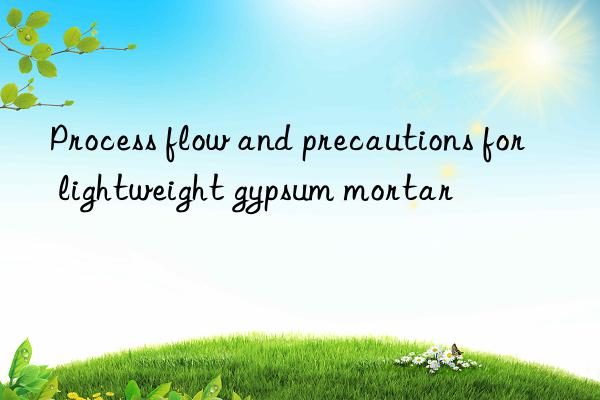
Lightweight gypsum mortar is a material for wall decoration, and it is the most basic material for the wall. Before construction, we need to clean the dust, stains, oil stains and other impurities on the base layer. Keep the wall flat and fill in the gaps between door and window frames. During construction, deal with the ceiling first and then the wall. The entire sequence should be from top to bottom, starting from the door side. The stucco plaster should not be stored for too long. It is only suitable for drying. For use in rooms, it is not suitable for painting kitchens and bathrooms. The editor will introduce it in detail below.
1. Process flow of lightweight gypsum mortar
1. Base treatment
1) Before construction, dust, oil stains, dirt, isolation materials and other impurities on the surface of the base layer should be cleaned in advance.
2) The concave and convex parts and holes on the base layer must be dealt with clearly and kept flat and firm.
3) The gaps between the door and window frames and the wall should be filled closely according to the doors and windows made of various materials.
4) First, wet the base layer with water in advance. Before plastering, be careful that there is no open water on the surface.
5) Start making corner guards around walls, doors, windows and pillars.
2. Plastering process
1) Ceiling
Elastic line - plaster cake - lower ruler - upper ruler - plaster cement window sill - wall punching - plaster base plaster - plaster surface plaster.
2) Wall
Follow the rules and apply gray cake - wipe the skirting - do it Corner protection for door and window openings - plastering cement window sills - wall punching - plastering primer - plastering surface plaster.
3. Operation process
1) Determine the order of plastering, first up, then down, from the door Starting from one side, work continuously on the entire wall.
2) Ordinary concrete ceilings can be plastered with plaster;
3) Required According to the flatness of the base layer of the wall, set signs or bars; the distance between vertical bars should be 1.2-1.5 meters, and the width of the bars should be 0.03-0.05 meters.
4) If the plastering thickness is less than 0.05 meters, you can directly use light gypsum mortar for plastering. If it is more than 0.05 meters, you can directly use a light base layer. Then use the surface layer to plaster the gypsum cover;
5) Apply the light gypsum mortar to the base layer according to the designed thickness, and then use an H-type ruler and scraper The board should be close to the marking ribs, and the surface layer of dust should be scraped up, down, left and right.
6) Use a trowel to calender, and then use a ruler to check the flatness of the wall;
7) After plastering, special attention should be paid to cleaning the relevant locations in time.
8) When plastering with gypsum plastering mortar, it is necessary to clean up the floor ash. After calendering, pay attention to good ventilation and avoid washing the finish with water. After the construction is completed, remember to clean the plastering tools in time.
2. Precautions for plastering lightweight gypsum mortar
1. Storing and transporting plaster It is easy to get damp during the process, so the storage time should not be too long. In principle, it should be used within three months. If any lumps are found during use, they should be screened before use.
2. The initial setting time of light plaster mortar usually takes about an hour, and the complete setting time is about four hours, so do not mix when mixing the mortar. If there is too much ash, avoid adding water for secondary mixing during use, which will reduce the strength of the plaster gypsum slurry and cause great losses.
3. After construction is completed, the remaining mortar on doors, windows, water and electrical pipes, structural layers, etc. must be cleaned in time to strengthen the protection of finished products and keep the room dry and ventilated.
4. Plaster plaster is only suitable for indoor dry environments. It is strictly prohibited to use bathroom and kitchen lights in humid environments. </p



 微信扫一扫打赏
微信扫一扫打赏
